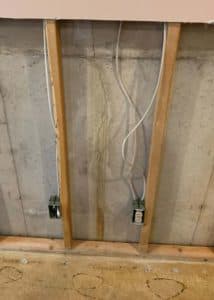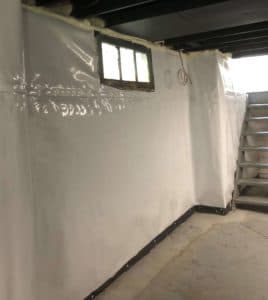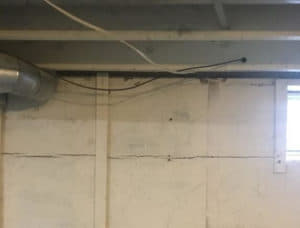
If you’ve found a crack in your basement wall, you’re probably worried about it. What caused it? Will it get worse? How should you fix it, and what will the repairs cost? For most of us, our home is our greatest investment. Anything that reduces our home’s value or threatens our security is a very serious concern.
At Acculevel, we understand how important your home is to you. Founded in 1996, we’re a family-owned and operated company that specializes in foundation repair and waterproofing. We’ve helped more than 35,000 homeowners throughout the Midwest restore strength and stability to their homes. And we want to help you do the same!
In this article, we’re going to review what can cause cracks in a basement wall, what these cracks can signify about your home and its stability, and the best concrete repair method for each one.
No matter what your foundation is made of, it’s probably a porous material. Porous materials allow water to pass into and through them; these include bricks, poured concrete, and cinder blocks.
Quick flashback to science class: what does water do, when there are significant temperature changes? It freezes and thaws, which makes it expand and contract. Sometimes the ground outside a foundation will do this, and it will cause the foundation to settle, or exert enough pressure on the basement wall to cause a crack.
The same thing is possible when a little water or moisture has seeped into the wall and the temperature changes. Regardless of whether the ground outside the wall (or the wall itself) is damp, the wall cracks because concrete isn’t flexible- it can’t “give way” a little bit when the moisture droplets change. We call these “hairline” cracks because they’re about the width of a single hair. (We discuss settling cracks later in this article.)
If there is more water in the ground than the soil can absorb, it will push against your basement walls. The industry term for this water pressure is hydrostatic pressure, and it’s a leading cause of both basement wall cracks and larger foundation problems.

This photo was taken by an Acculevel project advisor during a free in-home assessment. The crack begins very thin at the bottom, and slowly widens as it continues up the wall. Water has been seeping in through the crack.
Hairline cracks are a common occurrence, and aren’t always an immediate threat to your home’s health. That doesn’t mean they aren’t important, but If the cracks aren’t letting in any water, and you don’t have any plans to finish your basement? You don’t have too much to worry about. Yet. They should still be filled promptly to prevent them from becoming a bigger threat. Left untreated, hairline cracks will widen and let water into your basement.
The best repair method for narrow or hairline cracks in an epoxy fill. There are other methods out there, like the injection method. Acculevel has tested every option available, and we firmly believe that epoxy is the best and longest-lasting type.
What if you have cracks larger than hairline-width, or those cracks are letting water seep into your basement? Then your basement needs more help (and more expensive repairs).
The first problem is the water. Once water has found a way into your home, it will continue to do so. You can have the crack repaired, and it may hold for a while. Acculevel warranties epoxy repairs for 5 years. But epoxy has its limits, and water is very persistent.
We don’t want you to pay for repairs that aren’t going to last; our goal is to provide you with a whole-home solution that will protect your home into the future. If there is sufficient water intruding into your basement or the crack is large enough, you need waterproofing- not just crack repair.
Waterproofing is a misnomer; it doesn’t prevent the water from entering your basement. It controls or manages the water, to restrict where it can go. In order to waterproof a home, you need water drainage and a sump pump. If you have a finished basement (or think you want to finish it later), basement encapsulation is the best way to protect your drywall, carpet, and furnishings from getting water damage.

This photo was taken by an Acculevel crew member after installing water drainage and encapsulation in a customer’s basement.
You may be thinking that this is a big jump; we’ve gone from minor crack repair to waterproofing or even encapsulation! You may even think we’re trying to push you into spending more than you need to. But the fact is: if you don’t control the water trying to damage your basement, it can (and will!) get worse.
As hydrostatic pressure continues, it forces your basement to work like a dam, holding back the excess water in the soil. But your foundation is not built to be a dam; it’s designed to resist pressure from above, to support your home and all of its contents.
Simply put: the excess water pushing against the sides of your basement wall will eventually make it move. Those cracks that have been widening are weak spots, where the wall will lean or bow inward.

This photo was taken by an Acculevel project advisor during an in-home assessment. This long horizontal crack is where the wall is beginning to bow.
Bowing walls should be repaired as soon as you notice there’s a problem. The longer you wait, the more expensive the repairs will be. A bowing wall can become a collapsing wall. And there aren’t many things that are more damaging to your home’s structural stability than a failing foundation.
Sometimes, extra water in the soil doesn’t become hydrostatic pressure against your basement wall. Hydrostatic pressure is more likely to develop in expansive soil (with significant amounts of clay).
If you have granular soil (with sand or gravel in it, oversaturated soil leads to erosion, instead. This can sometimes cause cracks in your basement, but it’s more commonly detected in other places around your home. Signs of a settling foundation include:
All homes settle, especially in the first few years after construction. This process is the ground below the home compressing further under the weight of your house and its furnishings. It’s not a problem, because it usually happens consistently across the entire home.
Uneven settling is what causes problems. When water erodes the ground under one corner or section of your home sinks at a different pace than the rest. This strains the foundation and your home begins to try (and fail!) to stretch. Bricks, stone, concrete, wood- none of these are flexible materials that can accomodate the pull of an eroded foundation.

This photo was taken by an Acculevel project advisor during an in-home assessment. The cracks around the window indicate a settling foundation.
The best way to stabilize and repair a settling foundation is with helical piers. These piers are long steel posts shaped like screws. They’re drilled down into the earth into stabile soil, then secured to your foundation to hold it in place. The piers stop the home from sinking any farther, and in some cases can even be used to lift it back up.
It is critically important that you work with a foundation expert, if you need piers installed. An inexperienced contractor can misdiagnose or install piers in the wrong area- wasting your money without resolving the issue.
Throughout this article, we’ve provided links to additional resources. It’s our hope that these provide the information you need. But we’d like to also offer you another resource: our homeowner’s guide to foundation repair. This is available to all homeowners at no cost and we update it regularly with new products, options, and pricing details. Please bookmark it for your own future reference!
Call Acculevel at 866-669-3349, and we will schedule a free appointment with one of our knowledgeable and experienced project advisors. They will meet with you, discuss what symptoms you’ve noticed, review your needs, then fully evaluate your home and foundation.
Only once they’ve completed their assessment will they make recommendations. Our advisor will help you decide what your best course of action will be. Our goal is to provide you with complete whole-home solutions that help you protect and preserve your home for years to come.
If it’s after business hours (8 AM - 6 PM EST Monday-Friday), or if you prefer electronic communication, complete our online contact form instead. We’ll reach out to you once we return to the office, and answer any questions you have about our process.
Not sure if you live in our service area? You can check our customized map here. If you don’t live in Indiana or the surrounding areas, please make sure you work with a contractor who is insured and accredited by the Better Business Bureau. We also have a blog that explains how to find a reputable repair company in your area.
[DISPLAY_ULTIMATE_SOCIAL_ICONS]